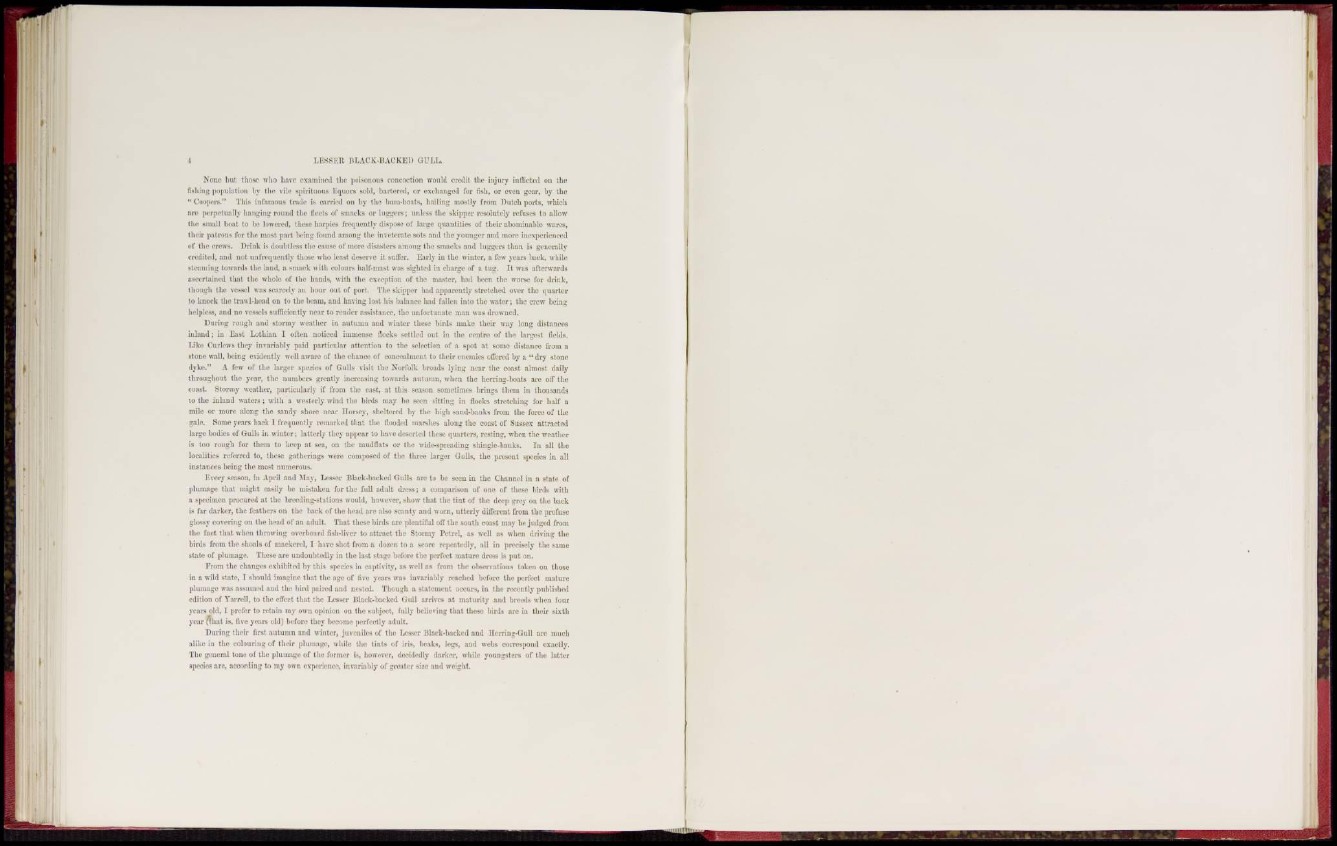
LESSEE BLACK-BACKED GULL.
None but those who have examined the poisonous concoction would credit the injury inflicted on the
fishing population by the vile spirituous liquors sold, bartered, or exchanged for iish, or even gear, by the
"Coopers." This infamous trade is carried on by the bum-boats, hailing mostly from Dutch ports, which
are perpetually banging round the fleets of smacks or luggers; utiles- I he skipper resolutely refuses to allow
the small boat to be lowered, these harpies frequently dispose of large quantities of their abominable wares,
their patrons for the most pari being found among the inveterate sots and the younger and more inexperienced
of the crews. Drink i- doubtless the cause of more disaster- among the -macks and luggers than is generally
credited, and not unlrequently those who least deserve it suffer. Early in tbo winter, a few years hack, while
•teaming towards the laud, a smack with colours half-mast was sighted in charge of a tug. It was afterwards
ascertained that the whole of the hands, with the exception of the master, had been the worse for drink,
though the vessel was scarcely tin hour out of port. The -kipper bad apparently stretched over the quarter
to knock the trawl-head on to the beam, and having lost his balance had fallen into the water; the crew being
helpless, and no vessels sufficiently near to render assistance, the unfortunate man was drowned.
During rough and stormy weather in autumn and winter these birds make their way long distances
inland; in East Lothian I often noticed immense flocks settled out in the centre of the largest fields.
Like Curlews they invariably paid particular attention to the selection of a spot at some distanco from a
stone wall, being evidently well aware of the chance of concealment to their enemies offered by a " dry stono
dyke." A few of the larger species of Gulls visit the Norfolk broads lying near the coast almost daily
throughout the year, the numbers greatly increasing towards autumn, when the herring-boats arc off the
coast. Stormy weather, particularly if from the east, at this season sometimes brings them in thousands
to the inland waters ; with a westerly wind the birds may be seen sitting in flocks stretching for half a
mile or more along the sandy shore near Horsey, sheltered by the high sand-banks from the force of the
gale. Some years hack I frequently remarked that the flooded marshes along tbo coast of Sussex attracted
rgobt die of Gulls n „
too b for th m
caliti rerred to tht
stacc Mb ing the n tost
localities referred to, these gatherings were composed of the three larger Gulls, the present species in all
Ev ery Apt
uraag a tl at might
ind May, Lesser Black-backed Gulls arc to be seen in the Channel in a state of
plumage that easily be mistaken for the full adult dress; a comparison of one of these birds with
a specimen procured at the breeding-stations would, however, show that the tint of the deep grey on the back
is far darker, the feathers on the back of the head are also scanty and worn, utterly different from the profuse
glossy covering on the head of an adult. That these birds are plentiful oil' the south coast may be judged from
the fact that when throwing overboard fish-liver to attract the Stormy Petrel, as well as when driving the
birds from the shoals of mackerel, I have shot from a dozen to a score repeatedly, all in precisely the same
state of plumage. These are undoubtedly in the last stage before the perfect mature dross is put on.
From the changes exhibited by this species in captivity, as well as from tin* observations taken on those
in a wild state, I should imagine that the age of five years was invariably reached before the perfect mature
plumage was assumed and the bird paired and nested. Though a statement occurs, in the recently published
edition of Yarroll, to the effect that the Lesser Black-backed Gull arrives at maturity and breeds when four
years old, I prefer to retain my own opinion on the subject, fully believing that these birds arc in their sixth
year f^bat is, live yean obi) before they become perfectly adult.
During their first autumn and winter, juveniles of the Lesser Illaek-backcd and Herring-Gull arc much
alike in the colouring of their plumage, while the tints of iris, beaks, legs, and webs correspond exactly.
The general tone of the plumage of Hie former is, however, decidedly darker, while youngsters of the latter
species are, according to my own experience, invariably of greater size and weight.